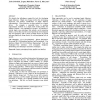Free Online Productivity Tools
i2Speak
i2Symbol
i2OCR
iTex2Img
iWeb2Print
iWeb2Shot
i2Type
iPdf2Split
iPdf2Merge
i2Bopomofo
i2Arabic
i2Style
i2Image
i2PDF
iLatex2Rtf
Sci2ools
HAPTICS
2006
IEEE
2006
IEEE
The Role of Prototyping Tools for Haptic Behavior Design
We describe key affordances required by tools for developing haptic behaviors. Haptic icon design involves the envisioning, expression and iterative modification of haptic behavior representations. These behaviors are then rendered on a haptic device. For example, a sinusoidal force vs. position representation rendered on a haptic knob would produce the feeling of detents. Our contribution is twofold. We introduce a custom haptic icon prototyper that includes novel interaction features, and we then use the lessons learnt from its development plus our experiences with a variety of haptic devices to present and argue high-level design choices for such prototyping tools in general.
| Added | 11 Jun 2010 |
| Updated | 11 Jun 2010 |
| Type | Conference |
| Year | 2006 |
| Where | HAPTICS |
| Authors | Colin Swindells, Evgeny Maksakov, Karon E. MacLean |
Comments (0)

